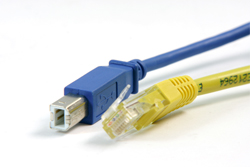Typically, the benefits of remote learning have been centered around students who attend school on a regular basis, attend lessons, and use various applications or internet services to augment their learning. Their teachers present them with well-planned lessons that incorporate both traditional methods of learning and technological ones. This blended learning approach is expected to become much more commonplace in future. Homework is set which requires students to log-on to the school network and download or submit work. Teachers can see what work has been completed, either on-site or remotely, and it is marked and recorded electronically. This process works effectively if the network has the right infrastructure and security systems in place.
Another important group of young people who rely on the school network, and in being able to log-in remotely, are those that are too sick to attend school due to medical or mental health issues. Medical issues include anything from broken limbs, post-operation recovery to life-limiting conditions. It is important not to confuse this group of young people who are educated at home by choice of their parents. Students who require the services and support of the home and hospital support services are in genuine need of 1:1 teaching and support, and to keep close links with their school. It is a statutory service from Local Authorities and teachers of this vulnerable group, who benefit enormously from blended learning, to rely on efficient and effective school network systems for the students to access and complete work online from home and keep pace with their peers. As with healthy students who access the school network remotely, a secure and reliable connection is crucial.
Pupils who have been absent from school for long periods of time often require a phased reintegration process, particularly those students with mental health issues. This may require the designated teacher to start the reintegration process by teaching sessions from home or in local libraries as an alternative teaching base to school. The most effective reintegration process is where the student is able to access applications, internet services and the school network via public, personal and home IT devices such as PCs, laptops, iPads, smartphones, etc. Terry Heick, Edudemic (July ’12), states that: "The use of instant messaging, online whiteboards, audio and webcams, means a student can have real time interaction". These develop an effective line of communication between the student’s school-based teachers and fellow students. Heick further states: "Being able to interact immediately is too valuable tool to settle for uncoordinated learning". A coordinated approach is essential to effective reintegration, and technology can play a huge part in achieving this.
Recently there has been an increase in the usage of Skype, FaceTime and video links via webcams creating a link between sick students and their school friends. Most young people also use social networking sites to keep in touch. Whilst Heick suggests that e-mail and chat are very impersonal for a student with long term medical conditions or mental health issues, these forms of communication can help them rekindle friendships, develop self-confidence, improve self-esteem and give them a sense of belonging, aiding their successful return to school.
The most effective and secure system to support remote learning is a Virtual Private Network (VPN). A VPN is a private network (school network) that uses a public network (the internet) to connect remote sites or users together. The VPN uses virtual connections routed through the internet from the school's network to the remote site or user. This enables students to access work at home on a wired device (PC) and wireless devices such as laptops, iPads, Smartphones.
Data transfer rate (bandwidth) via the Internet is also a key factor to increasing efficiency of the school’s network. At any one time, and this includes remote learners, there can be many different applications simultaneously passing data through a firewall onto the Internet, such as VOICE, Video conferencing, email, web browsing, on demand education videos, or social networking sites. Without sufficient management, everything is competing against each other and will result in poor performance of key applications. To ensure efficiency, the school’s network needs to be able to prioritise applications, users and times that will ensure the internet bandwidth is always optimised as well as able to block or set stringent rules on the usage of social media and inappropriate websites.
Maximising opportunities to access the school network, internet services and educational apps, either in school or on a remote basis, enables students to learn remotely using the same devices at home and in school. Without remote learning, students, including those disadvantaged by illness or mental health issues, wouldn’t have the same opportunities to fulfill their potential. It is therefore crucial that a secure connection to the school's network by remote devices is made possible.


















